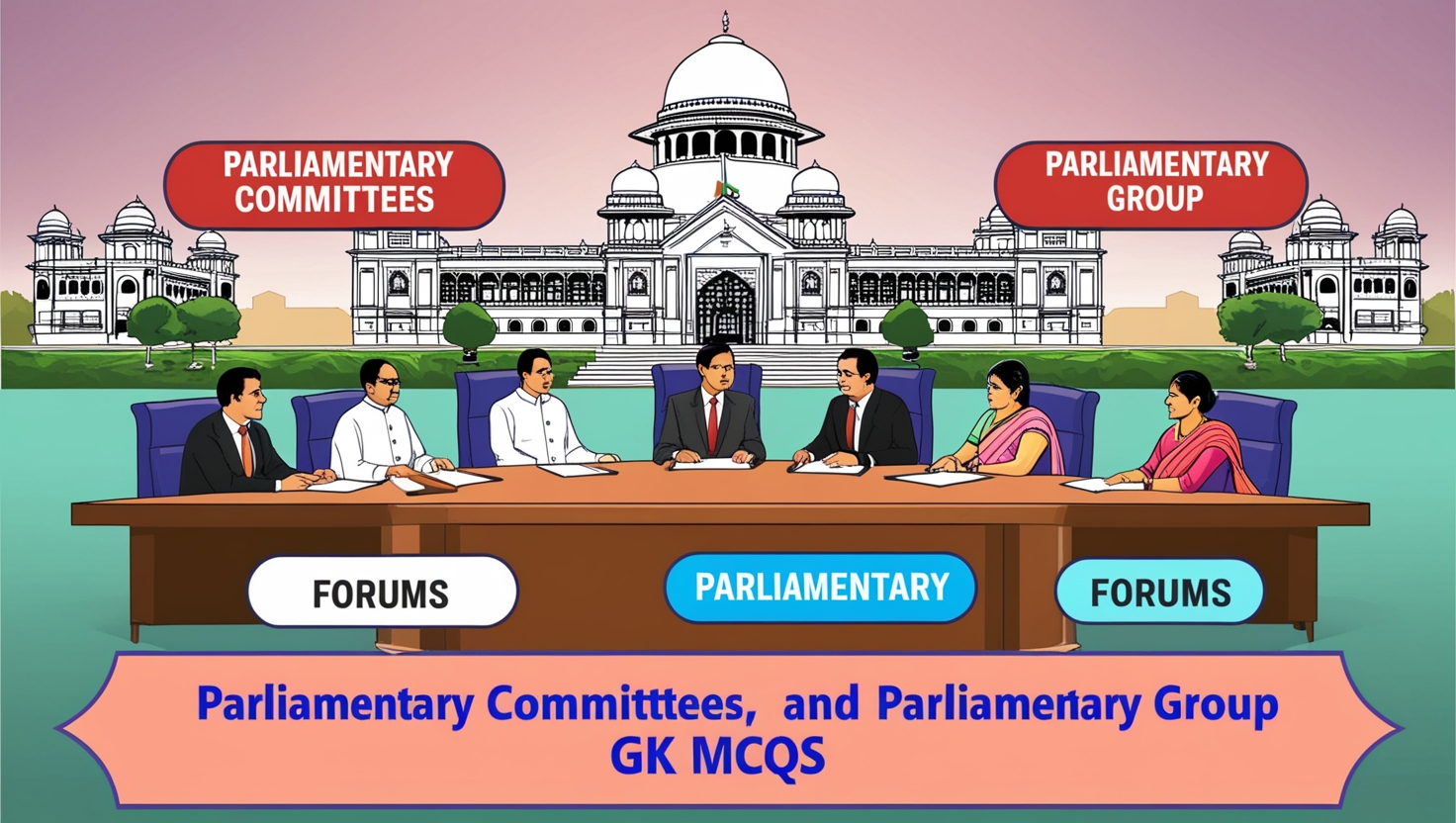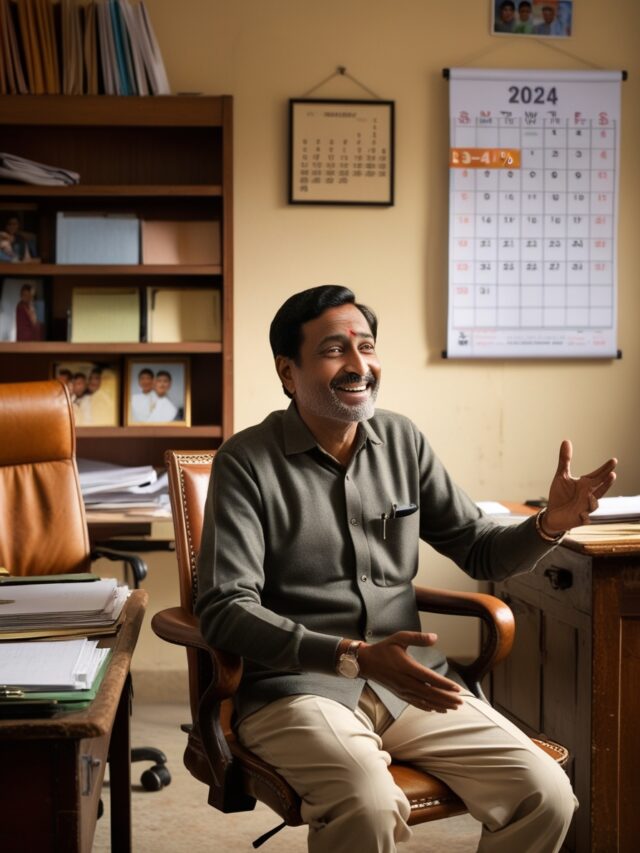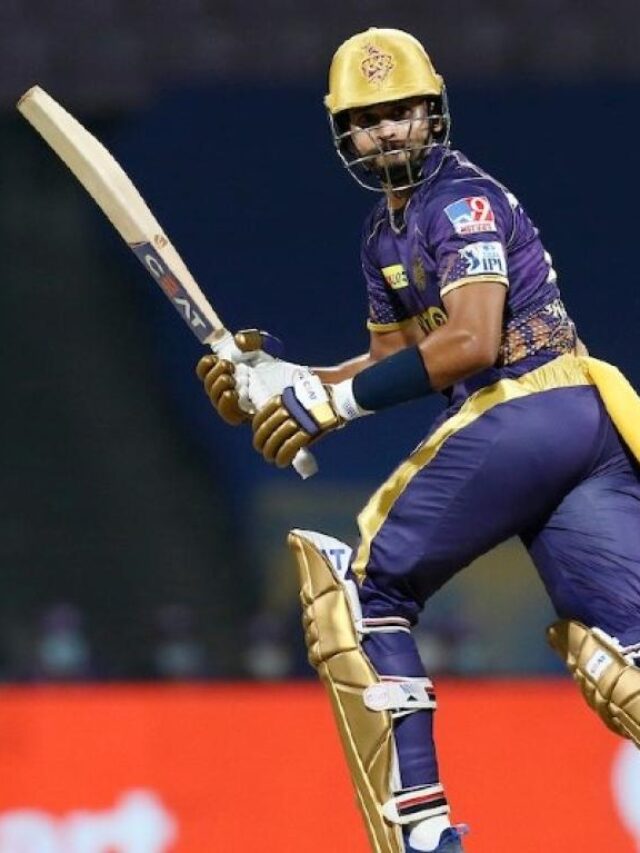
Parliamentary Committees, Forums, and Parliamentary Groups play a crucial role in the functioning of the Indian legislative system. These bodies ensure detailed scrutiny of bills, policies, and governance, aiding in more efficient decision-making. This article presents a set of Parliamentary Committees, Forums, and Parliamentary Group GK MCQs, designed to help you test your knowledge and gain a deeper understanding of these vital components of Parliament.
1. Which among the following is a correct combination of members in Joint Committee on Office of Profit?
- 15 from Lok Sabha and 5 from Rajya Sabha = Total 15 members
- 15 from Lok Sabha and 15 from Rajya Sabha = Total 30 members
- 20 from Lok Sabha and 10 from Rajya Sabha = Total 30 members
- 15 from Lok Sabha and 7 from Rajya Sabha = Total 22 members
Show Answer
Answer: 15 from Lok Sabha and 5 from Rajya Sabha = Total 15 members
The Public Accounts Committee (PAC) is a committee of the Lok Sabha that examines the annual audit reports of the Comptroller and Auditor General (CAG) of India. The CAG’s audit reports are presented before the Parliament by the President. The main function of the PAC is to scrutinize the audit reports of the CAG, which are laid before the Parliament by the President. The chairman of the PAC is nominated by the Speaker of Lok Sabha and is typically a member of the main opposition party.
2. Which committee of Lok Sabha is assisted by the Comptroller & Auditor General of India?
- Estimates Committee
- Public Accounts Committee
- Joint Committee of salary and allowances
- Joint Committee of Offices of Profit
Show Answer
Answer: Public Accounts Committee
The Public Accounts Committee (PAC) is the committee of Lok Sabha that examines the annual audit reports of the Comptroller and Auditor General (CAG) of India. The CAG’s audit reports are presented before the Parliament by the President.
3. Which among the following is a correct function of the Public Accounts Committee?
- It works under the President of India and creates accounts for various ministries.
- It works under the Comptroller and Auditor General of India and prepares accounts.
- It is a parliamentary committee that gives a report on non-plan expenditures of the government.
- It is a parliamentary committee that scrutinises the report of the Comptroller & Auditor General of India.
Show Answer
Answer: It is a parliamentary committee that scrutinises the report of the Comptroller & Auditor General of India.
The main function of the Public Accounts Committee is to scrutinize the audit reports of the Comptroller and Auditor General of India (CAG), which are laid before the Parliament by the President.
4. Who nominates the chairman of the Public Accounts Committee of India?
- Prime Minister
- President
- Speaker of Lok Sabha
- Chairman of Rajya Sabha
Show Answer
Answer: Speaker of Lok Sabha
The chairman of the Public Accounts Committee (PAC) is nominated by the Speaker of Lok Sabha. Since 1967-68, the chairman of the PAC is typically a member of the main opposition party, usually the leader of the opposition.
5. Which committee of Parliament considers the question of contempt of the House?
- Select Committee
- Committee on petitions
- Committee on privileges
- None
Show Answer
Answer: Committee on privileges
Both Lok Sabha and Rajya Sabha have their Committee on Privileges. These committees are responsible for examining cases of breach of privileges of the House and recommend appropriate actions. They have semi-judicial functions related to parliamentary privileges.
6. What is the main objective of the Parliamentary Language Committee?
- Recommend on making the progressive use of the Hindi language for the official purposes of the union.
- Looking into the linguistic demands for new states and making suggestions in that regard.
- Identify the endangered languages and make recommendations to protect and preserve them.
- Examine the vernacular education and make recommendations for the effective implementation of the three-language formula.
Show Answer
Answer: Recommend on making the progressive use of the Hindi language for the official purposes of the union.
The main objective of the Parliamentary Language Committee is to recommend measures for the progressive use of the Hindi language for official purposes of the union.
7. Which parliamentary committee recommends the allocation of time for discussion on various items in a House of Parliament?
- Business Advisory Committee
- Rules Committee
- Committee on Subordinate Legislation
- Committee on Papers Laid on the Table
Show Answer
Answer: Business Advisory Committee
Each House of Parliament has its own Business Advisory Committee. The Business Advisory Committee recommends the time that should be allotted for the discussion of government legislative and other business. It also suggests the allocation of time for discussions on various subjects.
8. What must be approved by the Public Accounts Committee before being submitted to the Lok Sabha for voting?
- Supplementary grant
- Exceptional grant
- Additional grant
- Excess grant
Show Answer
Answer: Excess grant
Excess grant is granted when money has been spent in a year in excess of the amount granted in the budget for that year for a particular service. Before the demands for excess grants are submitted to the Lok Sabha for voting, they must be approved by the Public Accounts Committee (PAC) of Parliament.
9. Which part of the Constitution deals with the organisation, composition, duration, officers, procedures, privileges, powers, and so on of the Parliament?
- Part IV
- Part V
- Part VI
- Part VII
Show Answer
Answer: Part V
Part V of the Constitution of India deals with the organization, composition, duration, officers, procedures, privileges, powers, and so on of the Parliament of India. It provides the constitutional framework for the functioning of the Parliament.
10. In which year were the Hindi names ‘Rajya Sabha’ and ‘Lok Sabha’ adopted by the Council of States and the House of People respectively?
- 1950
- 1952
- 1954
- 1956
Show Answer
Answer: 1954
In 1954, the Hindi names ‘Rajya Sabha’ and ‘Lok Sabha’ were adopted by the Council of States and the House of People respectively. The Rajya Sabha is the Upper House, also called the Second Chamber or House of Elders, while the Lok Sabha is the Lower House or the First Chamber or the Popular House.
Q11: In how many categories are the parliamentary standing committees classified?
1. 4
2. 5
3. 6
4. 7
Show Answer
Answer: 3
Explanation: The parliamentary standing committees play a crucial role in the legislative process and oversight of the government. They are classified into six categories based on the nature of functions they perform, including Financial Committees, Departmental Standing Committees, Committees to Inquire, Committees to Scrutinize and Control, Committees Relating to the Day-to-Day Business of the House, and House-Keeping Committees or Service Committees.
Q12: When was the first Public Accounts Committee set up?
1. 1921
2. 1931
3. 1949
4. 1955
Show Answer
Answer: 2
Explanation: The PAC was set up in 1921. Presently, the Public Accounts Committee (PAC) consists of 22 members, of which 15 are from the Lok Sabha and 7 are from the Rajya Sabha. The members are elected by the Parliament every year from amongst its members using the principle of proportional representation through a single transferable vote.
Q13: Which committee examines the annual audit reports of the Comptroller and Auditor General of India?
1. Committee on Public Undertakings
2. Estimates Committee
3. House Committee
4. Public Accounts Committee
Show Answer
Answer: 4
Explanation: The Public Accounts Committee (PAC) examines the annual audit reports of the Comptroller and Auditor General of India (CAG), which are laid before the Parliament by the President. The CAG submits three audit reports, including the audit report on appropriation accounts, audit report on finance accounts, and audit report on public undertakings.
Q14: When was the first Estimates Committee in the post-independence era constituted?
1. 1950
2. 1955
3. 1961
4. 1971
Show Answer
Answer: 1
Explanation: The first Estimates Committee in the post-independence era was constituted in the year 1950. The committee was initially recommended by the Rules Committee of Lok Sabha, and it played a crucial role in the scrutiny of government expenditure and budget estimates.
Q15: Who appoints the chairman of the Estimates Committee?
1. President
2. Prime Minister
3. Speaker of Lok Sabha
4. Chairman of Rajya Sabha
Show Answer
Answer: 3
Explanation: The chairman of the Estimates Committee is appointed by the Speaker of Lok Sabha from amongst its members. The chairman is usually from the ruling party and plays a significant role in examining the estimates included in the budget and suggesting economies in public expenditure.
Q16: On whose recommendation was the Committee on Public Undertakings created?
1. Punchi Commission
2. Sarkaria Commission
3. Krishna Menon Committee
4. Fazl Ali Commission
Show Answer
Answer: 3
Explanation: The Committee on Public Undertakings was created in 1964 on the recommendation of the Krishna Menon Committee. The committee’s primary function is to examine the working and performance of public sector undertakings (PSUs) in India.
Q17: How many Departmentally-Related Standing Committees (DRSCs) were created on the recommendation of the Rules Committee of the Lok Sabha in 1993?
1. 17
2. 18
3. 21
4. 25
Show Answer
Answer: 2
Explanation: The Rules Committee of the Lok Sabha recommended the creation of 18 Departmentally-Related Standing Committees (DRSCs) in the Parliament in 1993. These committees play a crucial role in scrutinizing the demands for grants of various government departments.
Q18: In which year was the first Parliamentary Forum on Water Conservation and Management constituted?
1. 2004
2. 2005
3. 2006
4. 2007
Show Answer
Answer: 2
Explanation: The first Parliamentary Forum on Water Conservation and Management was constituted in the year 2005. This forum, along with seven more parliamentary forums, was created by the government of India to address specific issues and concerns.
Q19: When was the Parliamentary Forum on Millennium Development Goals created?
1. 2000
2. 2010
3. 2013
4. 2015
Show Answer
Answer: 3
Explanation: The Parliamentary Forum on Millennium Development Goals was created in the year 2013. The forum focuses on issues related to the Millennium Development Goals, which were established by the United Nations to address various global challenges.
Q20: Who is the ex-officio President of all the Parliamentary Forums?
1. President
2. Prime Minister
3. Speaker
4. Chairman of Rajya Sabha
Show Answer
Answer: 3
Explanation: The Speaker of Lok Sabha is the ex-officio President of all the Parliamentary Forums, except the Parliamentary Forum on Population and Public Health. The Chairman of Rajya Sabha is the ex-officio President, and the Speaker is the ex-officio Co-President of the Parliamentary Forum on Population and Public Health.
Q21: What is the maximum number of members that a Parliamentary Forum can have?
1. 21
2. 25
3. 30
4. 31
Show Answer
Answer: 4
Explanation: A Parliamentary Forum can have a maximum of 31 members, excluding the President, Co-President, and Vice-Presidents. Out of these 31 members, not more than 21 can be from the Lok Sabha, and not more than 10 can be from the Rajya Sabha.
Q22: What type of body is the Indian Parliamentary Group?
1. Legal
2. Constitutional
3. Autonomous
4. Statutory
Show Answer
Answer: 3
Explanation: The Indian Parliamentary Group is an autonomous body. It was constituted in 1949 on the recommendation of the Constituent Assembly (Legislative). Membership in the Indian Parliamentary Group is open to all members of the Parliament of India.
Q23: Who is the ex-officio President of the Indian Parliamentary Group?
1. President
2. Prime Minister
3. Chairman of Rajya Sabha
4. Speaker of Lok Sabha
Show Answer
Answer: 4
Explanation: The Speaker of Lok Sabha is the ex-officio President of the Indian Parliamentary Group. Additionally, the Deputy Speaker of Lok Sabha and the Deputy Chairman of Rajya Sabha are ex-officio Vice-Presidents of the Group.







